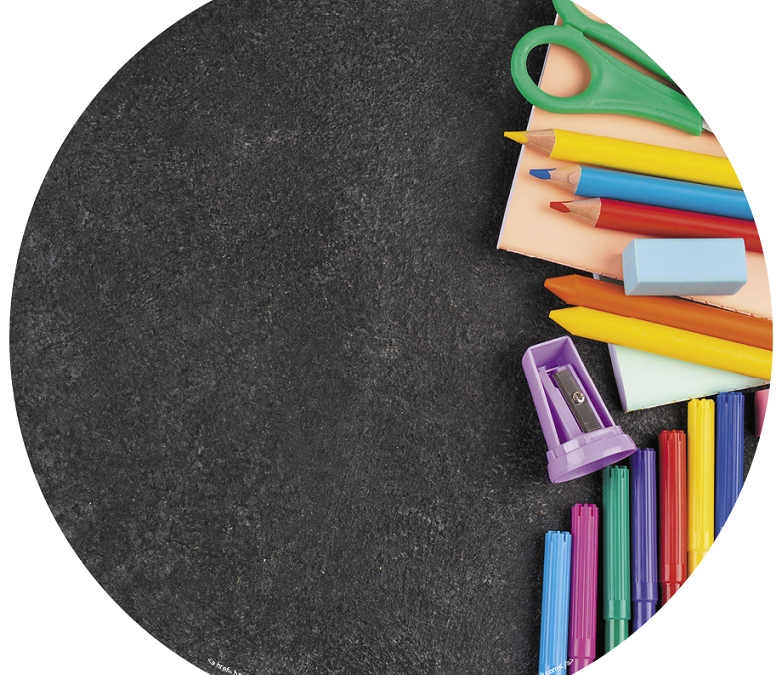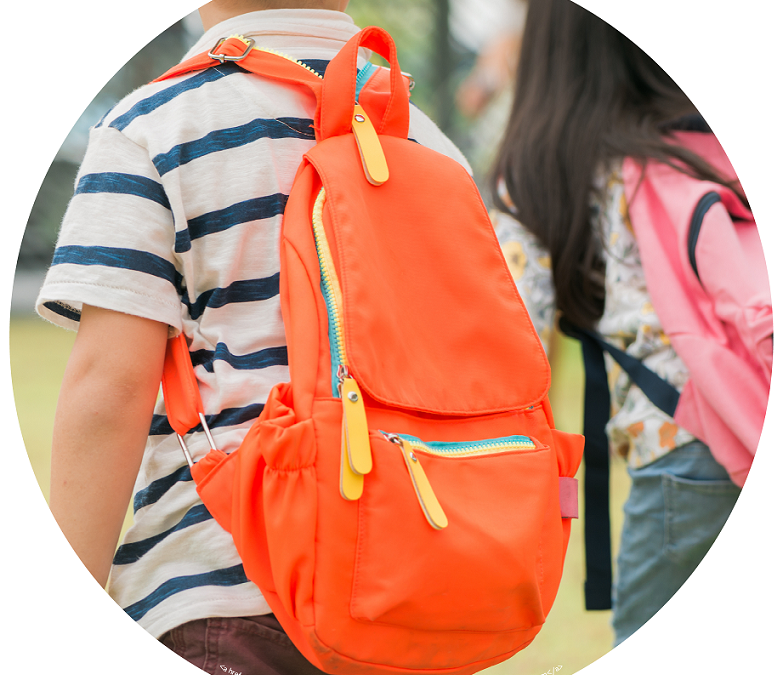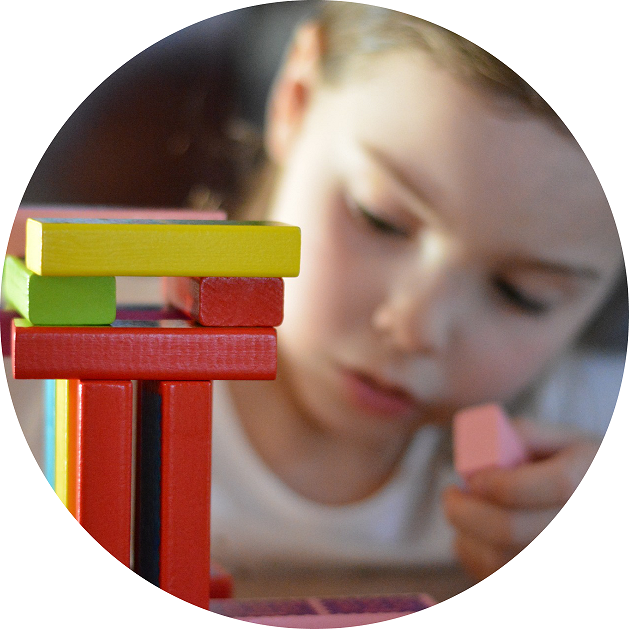
by IABA Team | Sep 6, 2021
We recently wrote a blog on what to do to start a smooth back-to-school transition for kids with ASD. The blog was fairly dense, so this one is going to take a more compact look in a checklist form for back-to-school needs.
ASD School Supply Checklist
Each school, daycare, or therapy clinic will have different requirements for school supplies. Before looking at our general list, you’ll definitely want to look over any list of supplies or materials provided by your child’s school.
The following are general items with brief guidelines to help you remember what your child may need at school.
- Lunch box. Having a reusable lunch box with compartments may help your child get into a regular lunch routine. Buying several of the same lunch boxes can help if you don’t have time to wash one every day. Compartments in lunchboxes can help your child understand where their regular lunch foods will be every day.
- Comfortable Clothing. Make sure your child is comfortable with all of the clothing they will be wearing to school. This is especially important for children with sensory issues as new clothing may not be comfortable. Be sure to have your child wear any new clothes at home before sending them to school in a new outfit. Buying the same outfits may also help some children get into a routine for school every day.
- Comfort Items. Make sure your child has their favorite comfort item to bring to school each day. Things like stuffed animals or a favorite blanket may help your child settle into a comfortable routine at school each day.
- Consistent School Supplies. After looking at a supply list provided by your child’s school, go shopping with your child and allow them to pick versions of the supplies they are comfortable with. Remember to buy extras of expendable supplies so they will have the same item they are comfortable with after the first one is done.
- Organized Backpack. A backpack with extra pouches or internal dividers is a great way to set up your child’s bag for easy use that can help them get into a regular school routine. Putting things in the same place can help them remember where their things are throughout the school day.
- Sensory Items. If your child has specific sensory issues, be sure to have a specific sensory comfort item packed in their backpack. Textured items like smooth stones or blankets made from specific materials can help if your child needs comfort during the school day.
- Books. Packing specific books can also help your child deal with difficult times during school. Books are a combination of comfort items and sensory items, as a teacher or aide can read the book to them if needed.
- Emergency Sheet. Be sure to include any information a teacher, aide, or therapist may need in your child’s bag. This sheet should include any and all information regarding sensory issues, specific behavioral issues, preferences, and anything else they may need to know if your child is having a difficult time.
- A Phone for Emergencies. This is not a phone for your child, but a phone for the teacher to use if your child really needs a parent. Definitely talk to your child’s school about policies and procedures for phones–don’t just pack one in their backpack. A basic flip phone is all that is required for emergencies where a parent is needed right away.
Remember, not all of these things will be required for your child. This list is for supplies you may have forgotten as the school year got here. Think of it as a list to jog your memory or help you modify school supplies to fit the needs of your child.
ABA Therapy from IABA Consultants
If you have questions regarding autism treatment, education, or plans using ABA therapy, we are here for you! Our goal is to make sure no family is turned away due to financial constraints. Our therapy team would love to talk to you. Find the location closest to you and give us a call. We’re here for you.
References
50 Back-to-School Tips from Autism Moms, Angelsense
Back To School Tips For Families With Autistic Children, Art of Autism

by Jessie Cooper | Aug 26, 2021
Over the past several weeks I’ve noticed a recurring topic of conversation within my tribe; “I’m exhausted from the last year and a half.” Each person that I speak with is talking about the COVID-19 pandemic and is in disbelief this is still our life. I keenly remember the start of the pandemic and how high all our emotions were running in fear of a threatening virus entering our world.
To still be dealing with that same stressor, with case numbers approaching levels from a year ago, exhaustion is an apt way of stating how we all feel. We’re not just dealing with a virus, we’re dealing with living our lives through an active, dangerous virus.
Trying to Find Peace During the Pandemic
With no end in sight, it’s hard to feel chipper and happy, let alone grounded. Peace can feel far away. I’ve heard a lot of “rinse, lather, repeat,” and “same shit, different day” comments in reference to what we are all walking through right now.
In the early days of the pandemic, Brene Brown spoke on her podcast, “Unlocking Us,” that she was just waiting for a checklist of what to do and once she had the checklist her recovering perfectionist could rest. Well, Brene, we have our checklist and the treatment fidelity is low. In scientific terms, this means we are not near containing the virus, which is incredibly frustrating.
As the virus carries on in all of our personal lives it can start to feel hopeless. The heart of the matter is this; we can provide good, accurate information and it’s up to each and every one of us to choose to follow it or not. We simply cannot control other people’s behavior.
Thinking About Others
I am going to pause here to let you know that not being able to convince a person to make a logical, kind decision (even in non-pandemic times) has been the bane of my existence. Truly. I have an aunt and sister who operate the same way. We see the systems for what they are. We see human life as incredibly worthy of equality and get frustrated (OK, sometimes livid) when decisions are made that move us away from equality and logic.
I am still on a journey of realizing that no matter how much I believe in making kind decisions that I cannot control other people and make them drink my preferred brand of logical, kind Kool-Aid. People are, in fact, allowed to make their own decisions and it’s incredibly frustrating when those decisions can potentially cause harm to others (please see the ongoing pandemic).
In light of being given a magical wand of authority, what spell could we possibly conjure in the midst of this climate of adversity? What can we do when a real stressor or danger is presented day after day with high and divisive emotions being publically shared?
It is easy to lash out at others, question their beliefs, invoke shame, or simply shut down into our own little world. I have been guilty of both at times. Neither has provided any long-lasting relief. But something else has and I’d like to share it with you.
An Attitude of Gratitude
I’ve recently written that I have been in the process of divorce, which is stressful enough by itself. The stress from the divorce on top of the pandemic took me to my limit. Early on I started following the work of Lee Harris. At the time I did not have more good days than bad, quite the opposite. Lee recommended a gratitude journal as part of a healing journey.
At first, this suggestion annoyed me. I’ve followed many different spiritual teachers for well over a decade and thought to myself, “I know, I know–an attitude of gratitude.” It felt like one more thing was being added to my checklist while my mindset was basically “what is there to be grateful for as my world is burning down?”
Lee gave a scientific reason, which at the time was just enough, that convinced me to begrudgingly start a gratitude journal. Lee explained that when you have experienced trauma your neurochemistry is depleted and leans more towards negative emotions. He went on to explain that writing five gratitude statements a day can change your brain chemistry. I was in need of rewiring and had already started acupuncture to rewire trauma inside my body. It felt right to rewire my mind so I started the journal.
At first, I wrote very small things like “I’m grateful for a Henry kiss goodnight,” “I’m grateful for Declan belly laughs,” and “I’m grateful for a dinner with my three boys.” I wrote moments each day that started to become a tiny light. As I leaned into this tiny light, I truly did begin to see more things to be grateful for regardless of the world around me.
I was able to move outside of the tiny gratitudes and see bigger things to be grateful for; a huge one being the incredible people that surround me. I call them my tribe but my family and friends are unmatched in their ever-present love of me (and my love for them). I am a lucky woman. In writing gratitude statements I was able to see that even when the world looks like it’s burning down around you, there is still more good than bad. Truly.
Staying Positive & Looking at the Good
My own external circumstances have not changed. I am still living in a pandemic and still dealing with a divorce while recovering from domestic abuse. I am still running a company during a pandemic. I cannot speed up any external circumstances beyond my control. They will stay, just as yours will stay.
I do not know when the pandemic will end. What I do know is that we can take care of our own hearts and minds even in stressful times. Especially in stressful times. I know what it feels like to want to wrap yourself in a blanket and cry the day away. I know what it feels like to scream in frustration at the top of your lungs. It’s OK to ride these feelings out. As they subside noticing what was beside you all along will shift your internal world. I promise.
The world outside is messy but I bet you have a few things to be grateful for. So, maybe even today, instead of arguing with someone for the millionth time about your stance on (masks, vaccines, the economy, etc) you could take a deep breath and call your mom. Tell her you love her. Can’t talk to your mom? That’s OK, call dad, a sister, a brother–make a phone call to someone you love. Say thank you. Then pick up the pen and find what you’re truly grateful for.
Xoxo,
Jessie

by Jessie Cooper | Aug 19, 2021
Over the past several months I have been writing about moving through anger while I’m doing it myself. Last week I gave you a glimpse into finding peace amidst adversity. The sun peeking through the dark forest, if you will. Personally, it is knowing the sun always rises that allows me to place my hands on the dark, damp, leaves of the forest and breathe in relief during pain.
As humans, we are conditioned to avoid pain for our own survival. As mammals, we have genetic coding to literally keep us alive. Yet as we developed as a social species and created hierarchies we also developed a great big lie (okay, many great big lies). The specific lie I’m writing about now is that the goal of life is to be happy and that happiness is obtained by achieving external desires.
The forever-running list of “if I just have, look, get, or accomplish I will be happy” purrs in far too many minds. It’s poison looping within our own minds telling us to escape anything that feels unhappy, anything that feels painful. I believe this is why so many of us choose what is wrong for us over what is right. Immediate escape to happiness over a lifetime of hard, right choices.
But what if we learned to choose differently? What if we chose to see pain as a powerful teacher and not something to fear? Pain as a phase and not a state of being? Pain as part of the human experience that allows us to live a fully abundant life? Not fully happy, but fully alive.
The Big Lie
I’ve struggled with this lie many times over my lifetime. Personally, I was not chasing external belongings but belonging itself. From this, I created a narrative of not wanting to do anything that caused harm to another person even if that person was hurting me. I thought by saying, “yes,” all of the time I could keep others happy and if they were happy we would all be connected and I would belong.
Then, when I belonged, I would be happy. I was a belonging junkie if you will. It took a very serious and dangerous situation in my own life to realize that I was dying from my own addiction to belonging. This situation forced me to face the pain of saying, “no,” even when it caused hurt to another person in order to truly find belonging in my own heart.
Saying what is right for yourself can be incredibly painful. It’s so easy to get lost in what is right for everyone else. Remember that part about humans being social animals? We genetically don’t just avoid pain; we also look for companionship, for our tribe. Sometimes we desperately want our tribe to be people who were never truly meant for us. Losing them is hard. Sometimes our own limits and boundaries feel life-threatening to those we love.
Don’t Lie to Yourself
I gently think of parents of a child struggling with addiction. You love your child yet through your love you have to let them go as you hold boundaries set by recovery teams. In less severe cases I believe all parents hold boundaries that can feel uncomfortable towards their own children.
Outside of parenthood, we all have a set of boundaries that protect our sacred selves. Boundaries are the lifeboat in the storm of life. The little raft you hold onto as the pain crashes around you and keeps you afloat until you wash up onto the shore of your next chapter.
By choosing what is right for yourself you must be willing to lose everything the world says is right in order to be strong and wise enough to choose for yourself. Each decision that is right for your own heart is one wave closer to the shore. As you lift your weary head, look around, and start to swim towards the shore you will see some people floating behind you while those who have always been by your side are applauding from the shore.
Choosing what is right for you can be easy at times. Other times it will feel like it’s ripping your soul in two. Perhaps it is the ripping that creates the space for growth. Each right (and hard) decision is the only way to live the life you were born to live. Life isn’t about being happy and comfortable all the time. The abundance of human emotions and spirit are all-wise councils. I’m not sure how happiness alone has sat on the throne for so long.
Authenticity is knocking and she wants her seat back.
Xoxo,
Jessie

by IABA Team | Aug 17, 2021
Going back to school is tough for most kids, but especially so for kids with ASD. The change of scenery & routine from summer break to a school setting can be tough. The COVID-19 pandemic has made things especially difficult, which affects kids who were used to digital or in-home learning during the last school year.
So, how can we make it easier for kids with ASD to transition back to an in-school environment? There are many things that can be done, so let’s take a look.
Develop a Plan with Your Child’s Therapist or Doctor
Developing a plan with your child’s therapist, doctor, or other healthcare providers can help children with ASD smoothly transition into a new school year. Putting a plan in motion with rules & methods that will be consistent in school, therapy, and at-home settings can make a world of difference.
Make sure to have a clear schedule complete with calendar dates so your child is aware of the coming changes. Talking with your child’s therapist or other healthcare providers can help you select the best way to count down to important milestone days on your calendar.
Make a List of Your Child’s Skills & Needs
Having a prepared list of your child’s skills and needs will make any discussions with teachers or administrators easier. Being able to quickly ask and answer questions will allow you to get a full picture of what your child will need to expect.
Be sure to list strengths, weaknesses, sensory issues, and any other important parts of your child’s ASD-specific behavior. Having a list of these issues will help you quickly and efficiently communicate the needs of your child. Talking to your child’s therapist or doctor can help you build a list that will be sure to mention any special needs.
Talk to a School or School District Administrator
Finding out how your child’s school or school district helps children with ASD is a huge priority for your back-to-school plans. Learning about the specific resources available for your child at school will help you make decisions about the school year.
Depending on the level of care your child needs, some school districts offer great special education programs geared towards kids with ASD. Sometimes different options are available for students with ASD, allowing parents to select the best option for their child.
This is just general information–every school district is different. To find out pertinent information for your situation, please contact the local school district. It may be wise to check out several surrounding school districts if you don’t like the programs from the district you live in.
Visit Back-to-School Settings Before School Starts
Taking your child to the school they will be attending early a few times may help them get used to the new setting. Walking through the hallways & classrooms, looking at the gyms & washrooms, and checking out the playground may help familiarize your child with the school. Try to get your child as comfortable as possible with the new school before the year starts.
An even better way to familiarize your child with their new setting is getting to meet their teachers several times before the school year. Getting to know the teacher or therapists at the school can help your child get comfortable with their new setting.
Re-Establish a School Schedule
It is very important to get your child back on a regular daily schedule before school starts. Establishing consistent bedtime and morning routines will help your child be ready for school. Starting this schedule a few weeks prior to school can help get your child on track for the school year.
Other scheduling issues may also be important. Here are a few examples of other scheduling things to keep in mind:
- Transportation times
- Eating times
- Nap times
- After school routines
- Weekend scheduling
- Any regular trips to therapy or the doctor
It is important to talk to your therapist or healthcare provider about weekend scheduling. Getting information about keeping the daily schedule on weekends or being a bit more flexible are questions you should find answers to.
Be sure to coordinate your schedule with the school (teacher, therapist, administrator, etc) to make sure your child stays on track.
Lastly, be sure to inform your child about any upcoming breaks, starting a few weeks before the break. Using a calendar or other time management system can help transition your child from regular school to break time more smoothly. Using social stories and visual aids on a calendar can help your child understand what’s on the horizon.
Establish an In-School Schedule
Working with your child’s teacher or therapist to implement a regular in-school schedule can help your child settle into a comfortable school year. Having daily school activities occur at the same time every day lets your child know what to expect each day. Working with your school or school district before the year starts to get a plan in place can help implement this strategy.
If your child has specific needs that revolve around a schedule, be sure to talk to the school, teacher, or therapist about how to tackle the issue. Having plans in place before something happens may help prevent difficult situations from arising.
Discuss Education Plans with Your Child’s Teacher
Most people won’t agree 100% on any school curriculum. This is especially true when it comes to education for children with ASD. You need to talk to your school or school district to see what kind of specialized education and methods will be used in your child’s classroom.
Don’t panic if you have minor disagreements with the teaching plan–sometimes it may be beneficial. We need to be clear though; if you think something sounds really wrong, be sure to call your child’s therapist or doctor and discuss the issue. It may be miscommunication but it may also be something that you should avoid. Talking to an expert on the issue can help you sort things out.
If your child has specific sensory issues, be sure that the teacher has a safe space to use in difficult situations. Having a place where your child can reacclimate at their own pace will help avoid specific situations. If your child has special needs for a safe space area be sure to discuss this with the teacher before the school year begins.
Try to Get Your Child Used to Social Situations
This information may not apply to every child; be sure to talk to your child’s therapist or doctor before planning anything.
Schools contain a lot of people in one building. Getting your child used to more people being around by taking trips to more populated areas or running errands to larger stores may help prepare your child for the transition to school. Situations with other people involved may help your child get used to many different people being around in their school.
Talk About COVID-19
The COVID-19 pandemic is still ongoing, and many schools have different rules when it comes to things like masks. If your child has sensory issues with wearing a mask or using sanitizer you need to talk to your child’s school and your therapist or doctor to develop a plan.
Learning about your school district’s health policies can give you the information you need to discuss masks, sanitizing, and other COVID-19-related issues. Special accommodations may be able to be put in place for your child’s needs.
Be sure to acclimate your child to any COVID-19 procedures that will be used at school prior to the school year starting.
Keep Communicating with Your Child’s School
It is extremely important to keep regular communications with your child’s teacher and anyone else regularly involved with your child. Hearing about your child’s progress, issues, and general behavior will allow you to evaluate any immediate needs as soon as they pop up.
Talking with your child’s therapist or other healthcare professional can help you put together a list of questions to ask for status reports. Having a consistent report can show how your child is progressing and behaving on a regular schedule.
Stay Interested & Involved
We want to finish up with the most important piece of information regarding transitioning a child with ASD back to school; Stay interested and involved. None of the things above will stick if your child isn’t receiving attention and care at home. Following a schedule and engaging in activities that are in place in therapy, at school, and, most importantly, at home can help your child maintain consistent behavior.
Showing interest in your child’s school activities and progress can help them progress even more than just setting a plan. Using visual aids, like a calendar with milestone stickers, may help your child understand the progress they are making in school.
Again, talk to your child’s therapist, doctor, or other healthcare professionals to find the best way to stay engaged with your child’s education. Every child is different. Be sure your child is getting the best care they can by staying involved.
ABA Therapy from IABA Consultants
If you have questions regarding autism treatment, education, or plans using ABA therapy, we are here for you! Our goal is to make sure no family is turned away due to financial constraints. Our therapy team would love to talk to you. Find the location closest to you and give us a call. We’re here for you.
Sources
Helping Kids with Autism Transition Back to In-Person School, UC Davis
Back to School: 17 Tips to Help, Autism Speaks
Preparing for Back to School, Autism Speaks
Students with Autism, publicservicedegrees.org
COVID Autism Back to School Transition, Stonybrook Medicine

by IABA Team | Aug 17, 2021
Early social skills are emerging as one reliable indicator of ASD. Some research suggests that children who lack social gestures are likely to have pronounced autism traits later on and follow a lower skill trajectory.
In a 2017 study of 199 autistic toddlers and preschoolers, researchers found that the children who made few social-communicative gestures, such as pointing and imitating adults, had more severe autism traits a year later. The research showed these social behaviors predicted autism severity better than repetitive behaviors or living skills.
Conversely, children whose autism traits diminish tend to be relatively social early on. A 2020 study looked at toddlers who sought out social interactions and showed good pointing skills (to indicate objects) who ended up with only mild autism traits as adolescents.
Early Intellectual Abilities & Disabilities
Early intellectual ability can be another early indicator of ASD. In one study, autistic children who had intellectual disability (defined as having an IQ below 70) as toddlers were likely to show substantial difficulties both socially and academically through the age of 14.
On the other hand, children who show a substantial easing of autism traits and advances in life skills tend to be those without intellectual disability, experts say.
Adaptive Behaviors
Adaptive behaviors can also correlate with future academic success. A 2020 study had researchers analyzing records for 98 autistic adults from a study in which clinicians had evaluated daily living and other skills from ages 2 to 26. Using modeling software, the researchers divided the participants into two groups; those with low- and high-daily living skills.
Children in the high-skills group were more likely than those in the low-skills group to continue their education after high school, according to the research.
Socioeconomic Status
Socioeconomic status can be an early indicator of ASD, too. Low-income and minority children with autism tend to have less developed communication and adaptive skills in young adulthood than autistic children from more privileged backgrounds, according to a 2019 report.
Low-income children may have minimal exposure to early intervention programs to address speech, motor, and other difficulties. Family participation in these programs predicts “longer-term outcomes” during adolescence and adulthood.
Genetic Indicators
Many recent studies on genetics may also provide clues to a child’s future. About one-quarter of children with autism have a genetic variant linked to autism. Some of these may give rise to characteristic developmental paths. Data from a 2020 study looked at 65 people with an ASD-linked variant, aged 5 to 21.
The scientists assessed each person’s skill level and combined those data with families’ recollections about when these children had hit early milestones such as walking and talking. The team found that the children’s developmental course depended on the genetic variant they carry.
Children with an ADNP variant show significant motor delays almost across the board, generally not walking until 20 months or later. However, the earlier they do walk, the higher their scores on nonverbal IQ tests in childhood (ages 4 to 16) and young adulthood. In children with a CHD8 variant, early milestones do not predict their cognitive development as reliably. But the earlier they speak in phrases (whether at age 1 or 4, for example) the better their adaptive skills are likely to be in later childhood and young adulthood.
Research is still being conducted and analyzed on the relationship between genes and ASD.
ABA Therapy from IABA Consultants
If you have questions regarding autism treatment with ABA therapy, we are here for you! Our goal is to make sure no family is turned away due to financial constraints. Our therapy team would love to talk to you. Find the location closest to you and give us a call. We’re here for you.
Sources
Mapping the Futures of Autistic Children, spectrumnews.org





